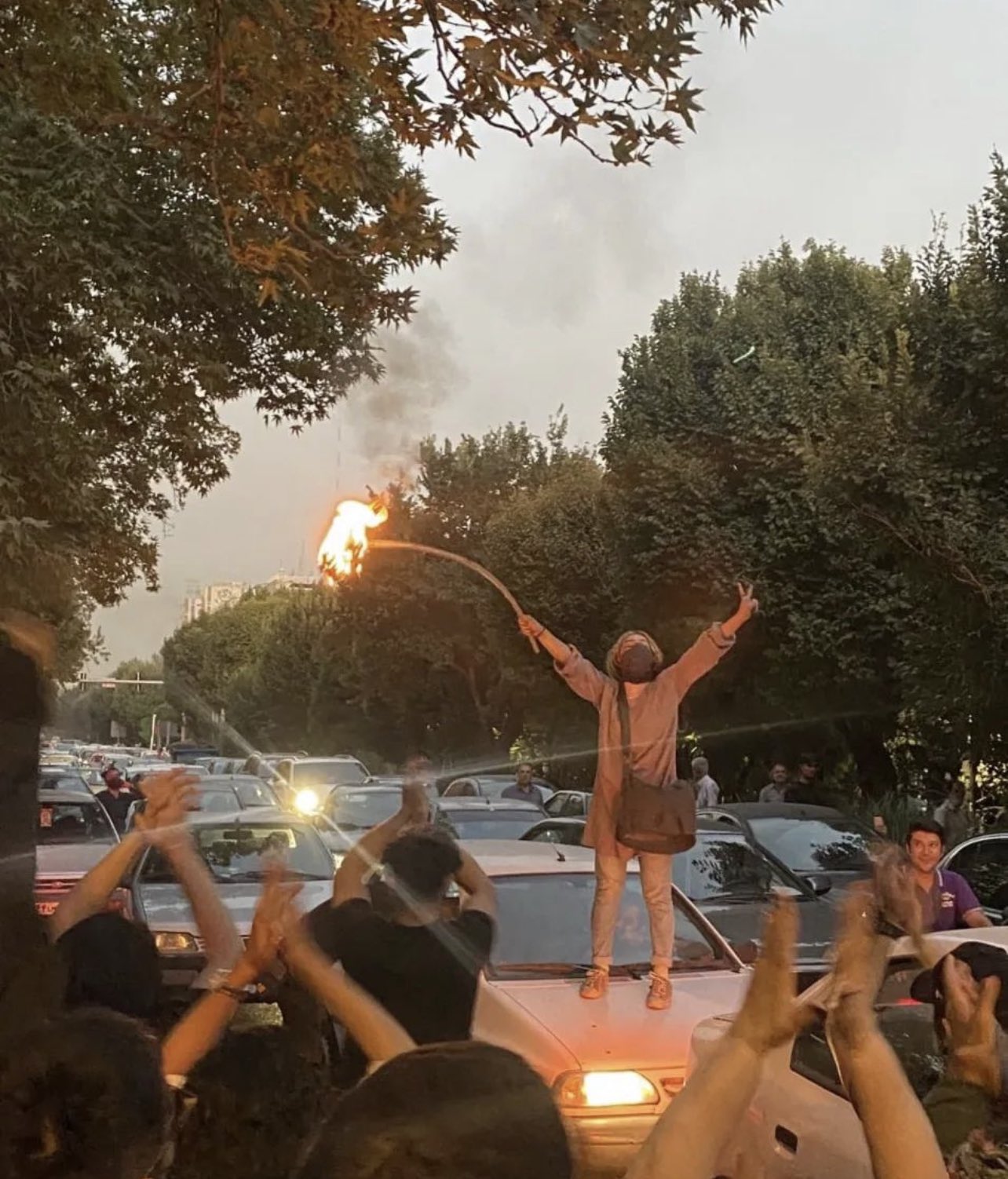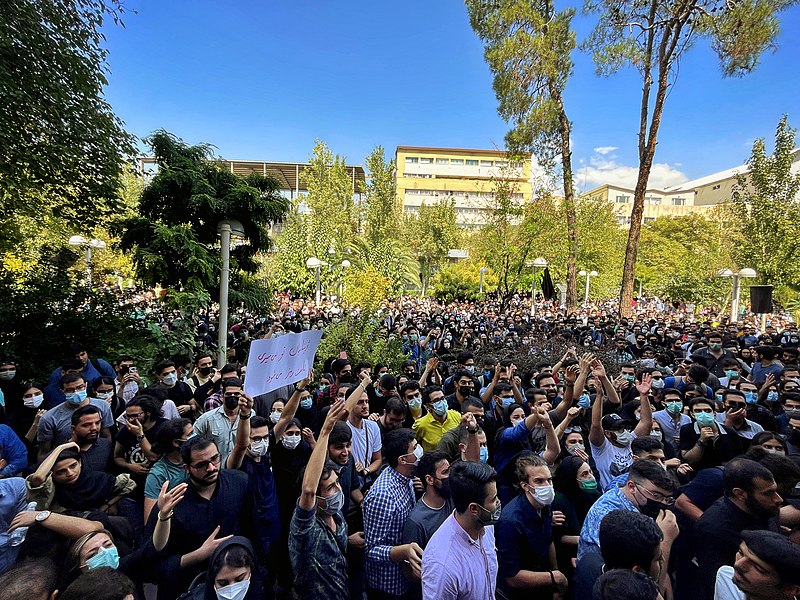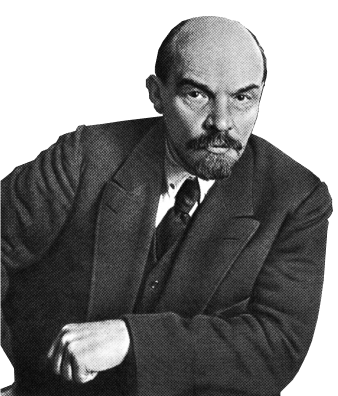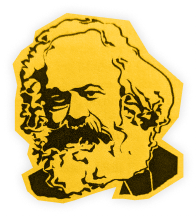
Protests have broken out all over Iran, following the murder of a young Kurdish woman, Jina Mahsa Amini, by Iran’s notorious morality police. Beginning in the Kurdish areas of Iran, the protests spread to more than 30 cities, including all the largest in the country: Tehran, Mashhad, Isfahan, Karaj, Tabriz and the so-called holy city of Qom. What started as a reaction against police brutality has quickly turned into a mood of rage against the regime as a whole.
Mahsa, originally from the city of Saqqez, but on holiday in Tehran, was arrested by the morality police on the evening of Tuesday 13 September for wearing her headscarf improperly. She was dragged into a van and taken away for “re-education”. Mere hours later, she was pronounced braindead. The regime initially dismissed any wrongdoing, releasing CCTV footage that supposedly showed a healthy-looking Mahsa Amini collapsing due to a purported heart attack. Under the pressure of rising protests however, a report of a CT scan has later been said to reveal a bone fracture, haemorrhage, and brain edema, which would confirm that she died due to being struck on the head.
Upon hearing the news of her death, protests spontaneously sprang up across the country. In Tehran, thousands gathered around Argentine Square and Sai Park. Heavyhanded police intervention eventually dispersed the protesters but protesters soon found a way back on the streets clashing with the police and anti-riot forces, chanting openly political slogans such as: “Death to Khamenei”, “Khamenei is a murderer – his regime illegitimate”; and “Women are oppressed – From Kurdistan to Tehran.”
Spearheading the protests in Tehran have been the university students, who have come out in their thousands and in every university of the capital, even in those who have previously shown few signs of political activity. At Tehran’s elite Amirkabir University, the top educational institution in the country, students were chanting: “The whole [of] Iran is covered in blood: from Kurdistan to Tehran,” and “Killed for a scarf?” and “How long will this humiliation last?” Another popular chant at demonstrations was: ”Woman; life; freedom” – echoing the popular slogan of the ‘79 revolution: “Bread, jobs, freedom”, a slogan that has seen a revival in later years. To quell the youth, the regime mobilised the basij – a paramilitary youth organisation – on the campuses, but this has only provoked the slogan: “Death to the basij”.

Sizeable protests, often led by women, took place in all the major cities, covering the majority of the regions of the country, with the main unifying slogan being “Death to the dictator” – a direct challenge to the supreme leader Ali Khamenei and thereby the foundations of the regime as a whole.
In Karaj, the industrial suburb of Tehran and Iran’s fourth-largest city, protesters have put forward the slogan: “Rue the day we will be armed”. This slogan has spread to many other areas. In Rasht, crowds were chanting it after beating up and chasing off fleeing basiji militiamen on Monday. Another, somewhat popular chant has been “Death to the oppressor whether it’s the shah or the Supreme leader,” referring both to Khamenei as well as to Mohammad Reza Pahlavi, the US backed son of the late shah, who has been campaigning for a constitutional monarchy.
In the city of Qom, the centre of the religious institutions and the major seminaries of the country, and a key base of the theocratic regime, crowds of young people took to the streets chanting: “Cannons, tanks, firecrackers, the cleric must get lost”. There are also videos from Qom showing a basiji militaman being beaten up by angry young men and women. In countless videos from all over the country, women were seen taking off their headscarves, often burning them in protest.
Regime security forces have reacted violently to the protests. At least seven people have been confirmed killed by the police and dozens more injured. Nevertheless, the crowds appeared to press forward with unyielding determination in the face of repression.
In Sari, there have been reports that a Basij headquarters has been burned down, as well as the governors’ office. In Amol, the governor’s office was taken over by the crowds and later burned down. The police have completely left the city centre. There has been no indication that any of the protests have been decisively suppressed. On the contrary, each blow of a truncheon and each shot fired seems to excite and agitate the crowds even more. In many cities there are reports that the police have had to operate in civilian clothes in order to avoid being beaten up. Numerous videos show police and paramilitary forces being attacked, beaten up or beaten back by angry crowds. The tables appear to be turning on the regime, which is now terrified of the prospect of a wider and generalised revolutionary movement.
The Kurdish areas in particular have been gripped by furious anger. On hearing the news of Mahsa’s death, thousands of young people responded by destroying images and symbols of the Islamic Republic, including images of Ayatollah Khamenei. Mahsa’s funeral procession on Saturday also turned into a protest, with women taking off their headscarves and tens of thousands chanting: “Death to Khamenei”. After the funeral, protesters began marching to the governor’s office. They were met with tear gas and security forces firing live ammunition, but fought back with equal measures. In many areas of Kurdistan, the last days have seen scenes akin to civil war, with protesters and counter-insurgency forces shooting at each other.
On Monday, this mood did not appear to be receding, with bazaar strikes breaking out in Saqqez, Bukan, Mahabad, Ashnoye, Baneh, Marivan, Sanandaj, Piranshahr and Mohamandshahr. There are now calls for a general strike across the whole Kurdistan region, including those in Iraq, Syria and Turkey. Strikes and protests of Bazaaris have since also spread to other cities of Iran including Tehran and Karaj.
The oppressed pushed to the fore
The Kurdish areas of Iran, which have longstanding revolutionary traditions, have been on the receiving end of regime discrimination and oppression for decades. These Kurdish areas, similarly to other areas inhabited by ethnic minorities, are home to large mineral, oil and water reserves, as well as dense forests, all of which play crucial roles in the Iranian economy. For decades, however, the regime has channelled these resources to industrial places in other, mainly Fars-inhabited areas, for processing while deliberately leaving Iranian Kurdistan underdeveloped for fear of creating a powerful Kurdish working class.
As a result, biting poverty and unemployment is widespread amongst Iranian Kurds. Meanwhile, any attempt to struggle for improved conditions have been met by harsh repression and punishment by the regime. In the past period this has provoked an increasingly militant response from Iranian Kurds, who have clashed with the police and military forces on a regular basis. In the murder of Mahsa Amini, the Kurdish people of Iran undeniably see a symbol of the the racism and chauvinism that underlies the actions of the regime towards them.
A similar point can be made about the women’s question. Every year, the morality police prosecute more than 16,000 women for wearing the hijab improperly. These women are subjected to verbal abuse and violence. Mahsa Amini was in fact only in custody for a few hours but ended up in the hospital after sustaining a vicious beating from these infamous brutes of the Islamic Republic. Eyewitnesses describe Mahsa and other prisoners protesting their charges, and being met with verbal abuse, beatings and pepper spray, ultimately leading to Mahsa’s coma.
Such injustices are common occurrences in Iran, where women are reduced to second-class citizens. Virtually all households economically supported by women are below the poverty line, making up the poorest tenth of society. If they wish to avoid total poverty, women have little choice but to be effectively shackled to their husbands. Every year, over 2,000 women are murdered in femicides, which make up 20 percent of all murders in Iran. The Islamic Republic upholds this horrific situation with its repressive laws.
On a daily basis, mullahs appear on television to preach the virtues of modesty and chastity. But they are complete hypocrites. In reality, they and their children live a life of extravagant excess – on par with wealthy westerners – indulging in every sin of the flesh: drugs, drinking, prostitution and all manner of abuse. Of course, they are never bothered by the morality police whose true purpose is to sow discord between ordinary women and men, and to terrorise the working masses.
In periods of relative calm in the class struggle, the ruling class can partially succeed in such endeavours. But that is not the period we are seeing now. The Iranian women are showing that they are unwilling to accept the fate decreed upon them by the mullahs. With admirable bravery, they have come out in very big numbers on the streets and in many cases, if not the majority, they are actually playing a leading role: taking off their scarves, chanting the most-radical slogans and often even leading attacking the security forces.
Women and other oppressed layers such as oppressed ethnic minorities always play an important role in revolutions. We saw this in the February revolution of 1917 where Russian working women and housewives led the initial charge pushing for a general strike. Similar scenes were witnessed in the Egyptian Revolution of 2012 and more recently in Sudan.
In normal times, the anger of the most downtrodden and oppressed is successfully drowned out by the ruling class. But once the masses begin to move, it is precisely this mood that most directly resonates with the general sentiment in society, propelling these layers to the forefront of the struggle, whereas the old “activists” and “revolutionaries” who for years have been working against the stream, and to a certain extent have been lulled to sleep by those experiences, are often caught off guard and relegated to spectators.
The Islamic Republic bases itself on the most-backward ideas of society in order to divide the masses against each other along the lines of religion, ethnicity and gender. Without such chauvinism the ruling class would not have been able to maintain its grip over society. From this it is clear that the struggle against oppression is an equally essential part of the Iranian revolution.
The masses can sense this instinctively and have rallied around the slogan of: “Woman, life, freedom”, which has now become the second-most popular slogan amongst the radicalised layers after “death to the dictator”. Likewise, countless slogans have surfaced in solidarity with the Kurdish movement. The students of Tabriz University made the following statement showing the developing mood of unity amongst the masses:
“One of the most beautiful slogans given in these protests was that ‘Azerbaijan is awake, it supports Kurdistan’.”
“Many groups tried to create differences between social groups, nations, tribes and different sections of the oppressed. But today, in brave and awakened Azerbaijan, we hear slogans of solidarity for the militant and awakened Kurdistan. Mahsa Amini’s last name means ‘we’. We are all, no matter where we come from in this country or what our backgrounds are: men and women, young and old, all of us oppressed and suffering, wage earners and workers and oppressed, we are all united.
“Long live the zealous people of Azerbaijan with this beautiful slogan. Long live the zealous people of Gilan who created unique epic scenes. Long live the people of Tehran, Khorasan, Isfahan, Qazvin and… and all the brave people who stood up against oppression.”
This shows how the mood of solidarity and unity in struggle is cutting through the reactionary azeri nationalism which has long had a presence in the Azeri areas of Iran.
Widespread support
Lenin once explained that revolutions are “festivals of the oppressed”. Once the movement begins to take off it draws the oppressed layers of society. Millions of workers, farmers, shopkeepers, unemployed, poor and dispossessed of Iran have been cheering on the youth on the streets today.
Each layer has its own grievances, but in the barbaric injustice with which Mahsa Amini was treated, they all see the thousand other injustices that are being served to them daily. A suffocating lack of democratic rights on top of crushing economic pressures, which have been piling up in the last few years, has made life unbearable for the majority of people. Meanwhile, the tops of the regime have become completely parasitic, seemingly existing only to steal from the poor, and in doing so committing the most heinous crimes with complete impunity.
The movement on the streets is providing an outlet and a focal point for this pent up anger and hatred, as well as an opportunity to be heard. Meanwhile, the youth and workers on the barricades are increasingly losing their fear and being emboldened by each advance and by each new layer entering the scene. A mood of revolutionary determination is spreading, which could potentially prepare the path for a mass movement. Combustible material has been gathering for some time, just waiting for a spark to set it off.
But the movement has not only affected the poorest layers. Following the death of Ms. Amini, condemnation of the regime and sympathy for the movement has poured in from a range of the middle layers in society, including intellectuals, artists, sports personalities (many of whom have previously been seen as apolitical or pro-regime), and even elements within the clergy, who are now calling for an end to imposed head scarfs. For the regime, this poses an existential threat.
Regime on the back foot
If the movement manages to sustain momentum and draw more layers onto the streets, the mullahs would be faced with a revolution – one that could easily topple them. They have clearly been taken completely aback by the developing situation. The Hammihan newspaper panickingly noted on Monday that: “every day new waves of social forces such as academics, civil society organisations, trade and professional groups enter this issue, take a position towards it and analyse it. […] Let’s not forget that this public sensitivity should not be presented as a product of [our] enemies and foreign media. […] This collective sensitivity is the product of the lived experience [of people] in the past years….” It went on to urge the authorities to stick to the law and perform a professional investigation. Seeing the potential for a social explosion inherent in the situation, the paper is warning the regime that it should refrain from its usual arrogant handling of such matters lest it provoke a larger, uncontrollable movement.
Fearing such a scenario, regime officials have cynically been trying to express their sympathy with Mahsa Amini. President Ebrahim Raisi reportedly told Mahsa’s father that their daughter was “like [his] daughter” and promised to investigate the matter. Of course, such talk is cheap, particularly coming after Raisi himself has been tightening headscarf laws and their enforcement. But it is precisely that Raisi, an avowed hardliner, who is taking such a conciliatory position is testament to the worries of the regime.
Similar calls have come from other institutions such as the judiciary and the parliament. Chief Justice Gholamhossein Mohseni Ajei has said that the government would “not give a free pass to the mistakes of government officials and agents, including the police force” in its “investigation” into Mahsa Amini’s death. He added that: “Whatever the outcome is, action will be taken without hesitation.” There have also been reports that the chief of the Tehran morality police has been suspended.
The working class must enter the scene
So far the movement has been gaining ground, day by day and hour by hour. It has widespread, albeit passive support. But the people on the streets are mainly confined to the tens of thousands of poor and student youth. In order to advance, the movement must consciously appeal to other layers of society, in particular the working class, to enter the struggle. The working class is the most powerful class in society, with the ability to bring the whole country to a standstill and break the back of the regime. We must remember that this is precisely what happened in 1979 when the decrepit regime of the Shah was finally defeated by a national general strike led by the oil workers, followed by the takeover of all the main industries by the working class.
In the past years we have seen the resurgence of the Iranian labour movement and the largest strike waves in 40 years. Many of the new trade unions have issued statements of support for the present movement, including the Teachers’ Coordinating Committee (a militant body representing striking teachers); the council for organising protests by contracted oil workers; and the Haft Tappeh trade union.
The oil workers’ council summarised the ongoing situation as the following:
“Women now play a clear and bold role in the social and protest movements, which have caused increasing panic and fear in the regime. The increasing intensification of repression and brutality from the regime has put society in a state of open rebellion, which highlights the necessity for unity to put an end to these brutal conditions.”
The militant Haft Tappeh workers echoed the calls for unity, but went much further by openly attacking capitalism:
“The repressive system of capitalism not only exploits and oppresses both women and men as workers but as women, ethnic and religious minorities in order to divide the working class. We believe that all oppressed groups, while fighting for their specific demands, must unite against the oppressors – against the capitalists!”
The Haft Tappeh union has now proclaimed that it will join the movement on the streets. That is a very positive step. However, in order to win, more is needed. What must immediately be raised is the slogan of a general strike to be prepared in all sectors of the economy. Councils of struggle must be set up in all neighbourhoods, schools and factories to prepare for a general strike with the aim of bringing down the regime.
If this uprising remains isolated it could be suppressed like all previous uprisings. The regime will wait and gather its forces, for the protests to tire themselves out; only to violently crush them. This was precisely the fate of the 2018, 2019 and the 2021 Khuzestan uprising.
The next few days and hours will show us how far this movement will develop. But regardless of the immediate events, what we are witnessing is the revolutionary reawakening of the Iranian masses. Iranian capitalism has never been capable of giving the masses a dignified existence, and this is especially true of women: it must be overthrown. The working class, united in struggle, is the only force capable of accomplishing this, and building a new socialist society that can address the needs of all the exploited and oppressed in Iranian society.
Woman, life, freedom!
Death to the dictator!
For a general strike to overthrow the theocratic regime!

